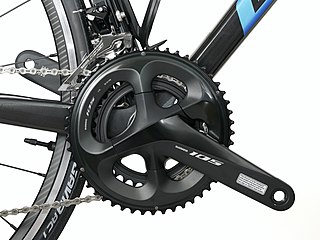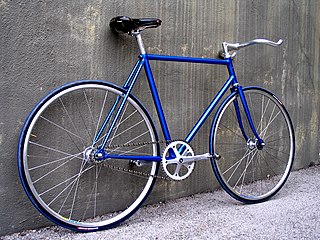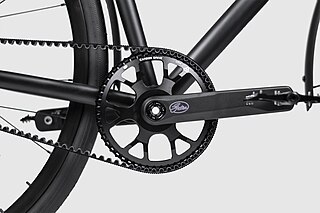Related Research Articles
Mechanical advantage is a measure of the force amplification achieved by using a tool, mechanical device or machine system. The device trades off input forces against movement to obtain a desired amplification in the output force. The model for this is the law of the lever. Machine components designed to manage forces and movement in this way are called mechanisms. An ideal mechanism transmits power without adding to or subtracting from it. This means the ideal machine does not include a power source, is frictionless, and is constructed from rigid bodies that do not deflect or wear. The performance of a real system relative to this ideal is expressed in terms of efficiency factors that take into account departures from the ideal.

A derailleur is a variable-ratio bicycle gearing system consisting of a chain, multiple sprockets of different sizes, and a mechanism to move the chain from one sprocket to another.

A hub gear, internal-gear hub, internally geared hub or just gear hub is a gear ratio changing system commonly used on bicycles that is implemented with planetary or epicyclic gears. The gears and lubricants are sealed within the shell of the hub gear, in contrast with derailleur gears where the gears and mechanism are exposed to the elements. Changing the gear ratio was traditionally accomplished by a shift lever connected to the hub with a Bowden cable, and twist-grip style shifters have become common.

The crankset or chainset is the component of a bicycle drivetrain that converts the reciprocating motion of the rider's legs into rotational motion used to drive the chain or belt, which in turn drives the rear wheel. It consists of one or more sprockets, also called chainrings or chainwheels attached to the cranks, arms, or crankarms to which the pedals attach. It is connected to the rider by the pedals, to the bicycle frame by the bottom bracket, and to the rear sprocket, cassette or freewheel via the chain.

A bicycle chain is a roller chain that transfers power from the pedals to the drive-wheel of a bicycle, thus propelling it. Most bicycle chains are made from plain carbon or alloy steel, but some are nickel-plated to prevent rust, or simply for aesthetics.

A touring bicycle is a bicycle designed or modified to handle bicycle touring. To make the bikes sufficiently robust, comfortable and capable of carrying heavy loads, special features may include a long wheelbase, frame materials that favor flexibility over rigidity, heavy duty wheels, and multiple mounting points.

In mechanical or automotive engineering, a freewheel or overrunning clutch is a device in a transmission that disengages the driveshaft from the driven shaft when the driven shaft rotates faster than the driveshaft. An overdrive is sometimes mistakenly called a freewheel, but is otherwise unrelated.

A track bicycle or track bike is a bicycle optimized for racing at a velodrome or outdoor track. Unlike road bicycles, the track bike is a fixed-gear bicycle; thus, it has only a single gear ratio and has neither a freewheel nor brakes. Tires are narrow and inflated to high pressure to reduce rolling resistance.

A sprocket, sprocket-wheel or chainwheel is a profiled wheel with teeth that mesh with a chain, rack or other perforated or indented material. The name 'sprocket' applies generally to any wheel upon which radial projections engage a chain passing over it. It is distinguished from a gear in that sprockets are never meshed together directly, and differs from a pulley in that sprockets have teeth and pulleys are smooth except for timing pulleys used with toothed belts.

Sturmey-Archer was a manufacturing company originally from Nottingham, England. It primarily produced bicycle hub gears, brakes and a great many other sundry bicycle components, most prominently during its heyday as a subsidiary of the Raleigh Bicycle Company. In the past, it also manufactured motorcycle hubs, gearboxes and engines.

A single-speed bicycle is a type of bicycle with a single gear ratio. These bicycles are without derailleur gears, hub gearing or other methods for varying the gear ratio of the bicycle.

A fixed-gear bicycle is a bicycle that has a drivetrain with no freewheel mechanism such that the pedals always will spin together with the rear wheel. The freewheel was developed early in the history of bicycle design but the fixed-gear bicycle remained the standard track racing design. More recently the "fixie" has become a popular alternative among mainly urban cyclists, offering the advantage of simplicity compared with the standard multi-geared bicycle.

Gear ratios of bicycles are relative measures of bicycle gearing giving an indication of the mechanical advantage of different gears, which combined with the wheel diameter determines how far the bicycle advances per pedal or crank revolution.

Chain drive is a way of transmitting mechanical power from one place to another. It is often used to convey power to the wheels of a vehicle, particularly bicycles and motorcycles. It is also used in a wide variety of machines besides vehicles.

On a bicycle, the cassette or cluster is the set of multiple sprockets that attaches to the hub on the rear wheel. A cogset works with a rear derailleur to provide multiple gear ratios to the rider. Cassettes come in two varieties, freewheels or cassettes, of which cassettes are a newer development. Although cassettes and freewheels perform the same function and look almost the same when installed, they have important mechanical differences and are not interchangeable.

The Rohloff Speedhub is an epicyclic internal hub gear for bicycles, developed and patented by Rohloff AG. It has been manufactured and marketed by that company since 1998. The Speedhub 500/14 has 14 equally spaced, sequential, non-overlapping gear ratios operated by a single twistgrip. The overall gear range is 526%, meaning the highest gear is 5.26 times as high as the lowest gear. Individual gear shifts when shifting up give an increase of about 13.6%.

Bicycle gearing is the aspect of a bicycle drivetrain that determines the relation between the cadence, the rate at which the rider pedals, and the rate at which the drive wheel turns.

A belt-driven bicycle is a chainless bicycle that uses a flexible belt, typically a synchronous toothed design, in order to transmit power from the pedals to the wheel.

Bicycle drivetrain systems are used to transmit power on bicycles, tricycles, quadracycles, unicycles, or other human-powered vehicles from the riders to the drive wheels. Most also include some type of a mechanism to convert speed and torque via gear ratios.
References
- 1 2 3 "Suntour Components Catalog 1992: MD (Micro Drive Design)" (PDF). The Bicycle Info Project. Retrieved 2011-08-18.
Smallest rings and gears: by reducing the diameter of the chainring bolt circle diameter on the crank arm, SUNTOUR is able to replace the standard 46/ 36/24 (or 48/28/28) with a compact 42/32/20 on the front chainrings.
- ↑ "Wheels / Hub Tech Help". Dan's Competition. Retrieved 2011-08-18.
Currently with a cassette hub you can run as small as an 8t cog.